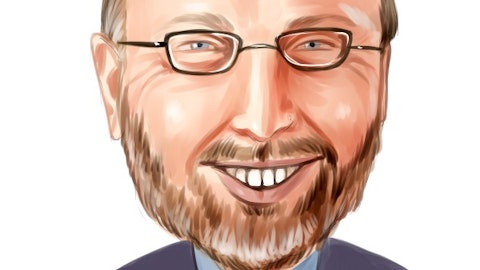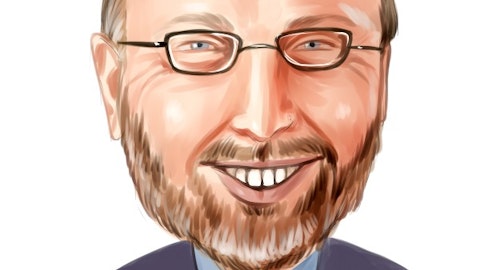Willis Towers Watson Public Limited Company (NASDAQ:WTW) Q4 2022 Earnings Call Transcript February 9, 2023
Operator: Good morning. Welcome to the WTW Fourth Quarter 2022 Earnings Conference Call. Please refer to wtwco.com for the press release and supplemental information that was issued earlier today. Today’s call is being recorded and will be available for the next three months on WTW’s website. Some of the comments in today’s call may constitute forward-looking statements within the meaning of the Private Securities Reform Act of 1995. These forward-looking statements are subject to risks and uncertainties. Actual results may differ materially from those discussed today in the company and the company undertakes no obligation to update these statements. One moment. Thank you. Some of the comments in today’s call may constitute forward-looking statements within the meaning of the Private Securities Reform Act of 1995.
These forward-looking statements are subject to risks and uncertainties. Actual results may differ materially from those discussed in today’s company and undertakes no obligation to update these statements unless required by law. For more details discussed of these and other risk factors investors should review the forward-looking statements section in the earnings press release issued this morning as well as other disclosures in most recent Form 10-K and in other Willis Towers Watson SEC filings. During the call, certain non-GAAP financial measures may be discussed. For reconciliations of the non-GAAP measures as well as other information regarding these measures, please refer to the most recent earnings release and other materials in the Investor Relations section of the company’s website.
I’ll now turn the call over to Carl Hess, WTW Chief Executive Officer. Please go ahead.
Carl Hess: Good morning, everyone. Thank you for joining us for WTW’s fourth quarter 2022 earnings call. Joining me today is Andrew Krasner, our Chief Financial Officer. In 2022, we focused on executing against our growth, simplify and transform strategic priorities, continuing to bring the best of WTW to our clients and generating value for our shareholders. I’m proud to say that we delivered on all of these commitments. Today, we are stronger, more resilient and better positioned than we were a year ago, and I’m excited about what we will achieve going forward. Our fourth quarter performance reflects the momentum we’ve been building and is a solid finish to a great year. In Q4, we delivered 5% organic growth, which brought our full year organic growth to 4%, in line with the mid-single digit forecast for 2022.
We also saw a modest margin expansion despite significant headwinds from prior year book of business settlement activity, which is expected to normalize going forward. We generated adjusted diluted earnings per share of $6.33, up 12% over the prior year fourth quarter. We also continued to execute against our capital allocation strategy completing another $440 million in share repurchases in the fourth quarter, bringing our full year total to $3.5 billion. Our transformation efforts continue to have a significant impact. During the fourth quarter, we realized $49 million of incremental annualized savings. This brings the total to $149 million in cumulative annualized savings since the program’s inception and positions us well to achieve our 2024 target of $360 million.
In advancing our simplified goals, we further refined our organizational structure by consolidating our Asia and Australasia operations into one Asia-Pacific region. This streamlined unit will be better able to leverage shared resources and to seamlessly serve clients in the region. Simon Weaver, who is previously the Head of Australasia will lead the new integrated region and be responsible for driving growth through closer collaboration across the business. For our grow initiatives, we remain focused on driving better outcomes for our clients through our innovative and differentiated offerings. Most recently, we launched a customized online platform for the aviation sector, which gives our clients access to WTW’s expertise across the globe 24/7.
Tailored to the unique challenges and needs of the sector, this platform allows airline and aviation-related clients to share technical expertise, news and insights, strengthening the breadth and depth of our client and industry relationships. We also advanced our grow initiatives with the recent introduction of WTW’s collaboration with Liberty Specialty Markets and Markel. Together, we launched the pilot phase of an innovative digital commercial insurance platform. This is a significant step forward in our broader strategy to transform our digital capabilities across the entire value chain. The venture will improve connectivity, giving brokers efficient, flexible trading options. Elsewhere within Risk and Broking, the ongoing rollout of our industry specialization strategy in CRB is producing great results with our global lines of business driving high-single digit organic growth.
We’re also excited by the traction our grow initiatives have gained within Health, Wealth & Career. Our focus on making connections across our businesses produced meaningful benefits in the fourth quarter with a noteworthy portion of our discretionary project sales referred by other businesses. In 2022, we made significant investments in rebuilding our talent base. WTW hired over 9,700 colleagues last year, demonstrating the appeal of WTW as a destination for talent. Our investment has translated into revenue growth in 2022, and we expect this to continue throughout 2023. We also saw the benefit of our retention efforts with voluntary attrition remaining in line with macro trends. As a result, WTW finished the year with 46,600 colleagues around the globe, an increase that has restored our headcount to 2019 levels despite the divestitures made since that time.
Overall, I’m pleased with our fourth quarter performance. The progress we have made to date, executing our strategic priorities to grow, simplify and transform gives us confidence that WTW is on the right path to drive sustainable growth and value creation. In the year ahead, we’re focused on further accelerating our growth, driving greater operating leverage and prioritizing cash generation. The current complex economic environment supports our ambitions. Our clients are facing many uncertainties, including inflation, rising interest rates, softer GDP growth, a tight labor market, ESG risk and potential recession. The regulatory focus on pensions in an uncertain economic environment is also heightened. As we’ve seen historically, such volatility can create strong demand for specialist work and products that our unique combination of businesses provide.
I’m pleased with our ability to help clients evaluate their risks and opportunities in these complex environments. For example, recent market dynamics have provided defined benefit plan sponsors for the increased funding levels, which in turn has created flexibility to explore a range of potential alternatives including modifications to investment strategies as well as pension risk transfer options. We’ve seen a significant increase in pension risk transfer projects, many of which evolved over multiple years and require a high degree of specialization. In addition, we’re seeing increased interest in clients reviewing their non-qualified benefits as well as investigating programs to manage their workforces, additional areas in which we are ideally placed to help.
Many of our clients also continue to navigate sustained rising commercial insurance rates across various lines, insurers are pushing for premium increases. This causes even greater challenges for our clients as they try to manage complex risks. We’re well-positioned to help clients through this difficult rate environment. Our customized tools ensure that clients get the best return for their premium dollar across their entire portfolio of risks. We call this Connected Risk Intelligence and believe it represents the future of financially efficient insurance buying. At the same time, we continue to build momentum. Our recent hires are becoming more productive. We’re getting faster, more agile and better connected and our transformation program is delivering.
We see continued demand from clients seeking our solutions to manage their unique challenges, which strengthens our conviction in achieving mid-single digit organic revenue growth in 2023. We expect to deliver another year of operating margin expansion led by an incremental $100 million in annualized transformation program cost savings and improved free cash flow. Andrew will share more details on our outlook for the year, but in short, we’re driving hard to achieve our long-term targets. In closing, our performance in 2022 demonstrated our focus on delivering on our commitments and our pursuit of profitable, sustainable growth. We believe that robust client demand in the face of a complex risk environment and the successful execution of our strategy will continue to drive momentum and we remain focused on achieving our goals and creating shareholder value.

Photo by Damir Kopezhanov on Unsplash
Last, but certainly not least, I want to thank our colleagues for their performance this year. I sincerely appreciate their dedication, service and continued commitment to our clients. And with that, I’ll turn the call over to Andrew.
Andrew Krasner: Thanks, Carl. Good morning, everyone. Thanks to all of you for joining us today. As Carl mentioned, we finished the year on a high note and our outlook for 2023 is positive. Now I’d like to share some further details on our financial results. The fourth quarter was in line with our expectations, with revenue up 5% on an organic basis. For the year, organic revenue growth was 4%, and we had solid growth across our portfolio of businesses. For the quarter, adjusted diluted earnings per share were $6.33, an increase of 12% over the prior year. For the year, adjusted diluted earnings per share were $13.41, representing 16% growth over the prior year. Now on to our detailed segment results. Note that to provide comparability with prior periods, all commentary regarding the results of our segments will be on an organic basis, unless specifically stated otherwise.
The health, wealth and career or HWC segment generated revenue growth of 5% on an organic and constant currency basis compared to the fourth quarter of last year. Excluding the year-over-year headwind from book of business settlement activity, HWC’s organic revenue grew 6%. Revenue for health was flat for the fourth quarter primarily due to a strong comparative arising from book gains in the prior year. Excluding this activity, health revenue grew 6%, primarily driven by portfolio growth and new client appointments in Europe and international as well as increased project work in North America related to helping clients manage increasing costs and implementing legislative changes. Wealth grew 5% in the fourth quarter. The growth was primarily attributable to higher levels of project work, actuarial valuation activity and new administration clients in North America and a combination of regulatory and settlement work in Great Britain.
This growth was partially offset by a nominal decrease in our Investments business, which was pressured by declines in capital markets, an expected headwind we mentioned during our third quarter earnings call. The Wealth business finished the year with a strong fourth quarter, offsetting declines experienced earlier in 2022. Career experienced 9% growth in the fourth quarter. This growth was largely driven by strong client demand for talent and compensation products, including compensation benchmarking surveys and advisory work, as well as employee engagement offerings, which we expect to continue this year. Benefits Delivery and Outsourcing generated 6% revenue growth in the fourth quarter. The increase was largely driven by individual marketplace, with strong growth from higher volumes and placements in Medicare Advantage policies.
As expected, TRANZACT delivered double-digit growth in its seasonally strongest quarter and for the full year, driven by a supportive macro environment and our focus on profitably growing the business. Technology and Administrative Solutions revenue also increased primarily due to new client appointments and increased project activity. We continue to see growth opportunities for these businesses and expect that they will continue their growth trajectory into 2023. HWC’s operating margin was 39% for this quarter compared to 38.2% in the prior year fourth quarter. Excluding the impact of book of business activity, HWC’s operating margin was 39% compared to 37.6% in the prior year fourth quarter. For the full year, HWC’s operating margin was 26.1% compared to 25.6% in the prior year.
The 50 basis point improvement was due to improved operating leverage and transformation-related savings. Risk and Broking revenue was up 5% on an organic basis and 3% on a constant currency basis compared to the prior year fourth quarter. Excluding the headwind from book of business settlement activity, R&B’s organic revenue increased 6%. Corporate Risk & Broking or CRB, organic revenue increased 3%. Excluding book of business settlement activity, CRB’s organic revenue growth was 5%. The business generated growth across all regions, driven by new business wins in construction, natural resources and aerospace. Excluding headwinds from prior year book of business settlements, North America revenue increased with notable growth in construction.
Europe and international also made strong contributions to CRB’s growth with new business in construction and aerospace. In the Insurance Consulting and Technology business, revenue was up 17% over the prior year fourth quarter, benefiting from the timing of software sales, which had originally been expected earlier in the year as well as increased advisory work. For the year, ICT delivered strong growth of 9%, in line with our long-term expectations for this business. R&B’s operating margin was 28.3% for the quarter compared to 30.1% in the prior year fourth quarter. Excluding the impact of book of business activity, R&B’s operating margin was 27.6% for the quarter compared to 28.3% in the prior year fourth quarter. For the full year, R&B’s operating margin was 21.2% compared to 23.4% in the prior year.
The decline in margin was due to our significant investments in talent. We expect these investments to continue to gain momentum in 2023 as the contributions of these hires become more meaningful. Now let’s turn to the enterprise level results. Adjusted operating income was $882 million for the quarter with 32% of revenue, a 20 basis point improvement over the prior year. For the year, adjusted operating margin was 20.9%, a 100 basis point improvement over the prior year. Our improved adjusted operating margins primarily reflect the benefits of strategic portfolio management which were realized at the corporate level, alongside transformation program savings, which were realized at the segment level, but in some of our businesses were more than offset by our increased investments in talent during the period.
As Carl mentioned, during the fourth quarter, we realized $49 million of incremental annualized savings. Transformation savings will continue to be a key aspect of our ongoing margin expansion efforts as we’re encouraged by the results this year, which exceeded both our original $30 million target for 2022 and our most recent forecast of $110 million for the year. To date, our transformation savings have outpaced our original expectations from a timing perspective, driven primarily by accelerated workforce savings, technology savings from migrating operations to the cloud and reductions in our overall real estate footprint. For 2023, we expect our transformation program to deliver approximately $100 million in incremental run rate savings by the end of the year with continued contributions from real estate, technology and process optimization.
Foreign currency was a headwind on adjusted EPS of $0.25 for the year, largely due to the strength of the U.S. dollar. Assuming exchange rates remain at current levels, we expect foreign currency to be a $0.06 headwind in Q1 of 2023, but only a $0.01 headwind for the full year. We generated free cash flow of $674 million for 2022 compared to free cash flow of $1.9 billion in 2021. This decrease was primarily due to the receipt of the $1 billion termination fee in the comparable period and the absence of cash generation from the divested treaty-reinsurance business. Looking ahead, growing earnings and generating healthy free cash flow remain our priorities. Our U.S. GAAP tax rate for the fourth quarter was 17.7% versus 20.8% in the prior year.
Our adjusted tax rate for the quarter was 22.2% versus 21.1% in the prior year, with the difference primarily due to the geographic distribution of profits. For the year, our U.S. GAAP tax rate was 15.4% versus 19.9% in the prior year. Our adjusted tax rate for the full year was 20.9%, more in line with the 20.7% rate in the prior year. In 2022, we returned a significant amount of capital to our shareholders, paying $369 million in dividends and repurchasing 15.7 million shares for $3.5 billion. We will continue to pursue a disciplined capital allocation strategy that balances capital return with internal investments and strategic M&A to deploy our capital in the highest return opportunities. While we expect share repurchases to remain the primary avenue for capital deployment, we continue to evaluate all our options to create value for shareholders.
Turning to our 2023 guidance. Based on current market conditions, we expect to deliver mid-single-digit organic revenue growth alongside adjusted operating margin expansion despite continued investments in long-term growth. We also expect an improvement in free cash flow now that onetime cash outflows primarily related to our divested treaty-reinsurance business are behind us. As I mentioned earlier, we expect to see $100 million in incremental annualized transformation program savings. With respect to non-cash pension income, we expect to see a decline due to market volatility and interest rate movements. For 2023, we expect about $112 million in pension income as compared to $271 million in 2022. I’d like to note that despite this dynamic, the funded position of our plans has improved.
We remain focused on our long-term targets and recognize that to achieve them, we will need to build on prior momentum and continue to accelerate revenue, margin and cash flow growth. Each of these areas remains the subject of significant management attention. Overall, it was a strong quarter and year for WTW with performance that aligned with our expectations. Our results reflect a lot of hard work, which included vigorous hiring efforts, investments in technology, successful transformation initiatives and the unwavering dedication of our colleagues. We ended the year in a solid position, and I’m confident that we will continue to build momentum in 2023 as we work to achieve our long-term targets. With that, let’s open it up for Q&A.
15 Dividend Stocks That Also Beat the Market and 16 Largest Photography Companies in the World.
Q&A Session
Follow Willis Towers Watson Plc (NYSE:WTW)
Follow Willis Towers Watson Plc (NYSE:WTW)
Operator: Thank you. Our first question comes from the line of Elyse Greenspan with Wells Fargo. Your line is open.
Elyse Greenspan: Hi, Thanks. Good morning. My first question. Can you guys just give us the impact of the book gains and the fiduciary investment income on both your revenue and margins for the fourth quarter as well as for the full year?
Andrew Krasner: Yes, sure. Thanks, Elyse. It’s Andrew. I think, as you point out, it’s meaningful to talk about those two components that underlie the revenue growth figures for the quarter. As you know, we had headwinds from gain on sale activities, and these were partially offset by sort of investment income. The tailwind from investment income was $24 million for the quarter and $43 million for the full year. And that was partially offset by the headwinds which we had from the gain on sale activity which was $65 million for the quarter and $63 million for the full year. I think it’s also important to note that we still would have had mid-single-digit organic growth and margin expansion absent those items.
Elyse Greenspan: Okay. Thank you. And then my second question is on free cash flow, right? Given where you guys were for 2022, I mean you’re still €“ you’re running short of that three-year target that you guys have laid out. And so €“ could you just get €“ is there a line of sight to getting into that free cash flow target? And can you just talk through some of the ways you’re looking to improve your free cash flow in 2023 and 2024?
Andrew Krasner: Yes, sure. As we discussed on the last call, we faced more headwinds on free cash flow than we originally anticipated, including our exit from Russia and timing differences from cash payments made in 2022 on both the termination fee and the Willis regain. Non-recurring working capital items, including these tax payments and other economic factors had a meaningful impact on free cash flow in 2022. Looking ahead, we’ve not provided any annual free cash flow guidance, but we do remain committed to achieving our cumulative three-year free cash flow target of $4.3 billion to $5.3 billion. We’re focused on free cash flow generation, we understand what is required to reach that target from where we are today, and we are lining things up to get there. We expect the one-off items and the related headwinds to abate we’re optimizing the cash generation profile of our business portfolio, and we’re focusing on tactical working capital improvements as well.
Elyse Greenspan: And then just one more quick one. So you did revise your 2024 EPS target last quarter. But then this quarter, right, you gave us the pension income guide, which is lower pension income for 2023. Is that embedded within the guide, the $17.50 to $20.50, right? That pension income will be lower, you would have a lower base in 2023 and still be able to get to that 24% EPS target?
Carl Hess: So Elyse, we’ve not adjusted our 2024 pension income assumption for the current headwind we’ve got in 2023. As we’ve seen during the last 12 months, a lot can happen when it comes to external factors, so a lot can change over the next two years as well. We do remain focused on driving organic growth, operating leverage and cost savings to achieve our long-term EPS target.
Operator: Thank you. Our next question comes from the line of Gregory Peters with Raymond James. Your line is open.





